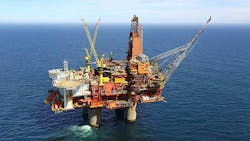North Sea Statfjord B enquiry critical of plan procedures
Offshore staff
OSLO, Norway — The Norwegian Ocean Industry Authority (Havtil) has served Equinor with notice of an order, following an investigation of a gas leak on the Statfjord B platform in the North Sea.
On April 24, 2023, Havtil decided to investigate the incident and to provide technical support for the police inquiry.
The incident arose during splitting of a blind hub on a new production pipeline, when the system was not fully depressurized. Pressure in the pipeline threw the 34-kg hub 1.5 m into the air: on the way down it hit one person, who suffered a broken nose and jaw.
In addition, a 2.15-kg sealing ring fell to the level below hitting a person there, although no injury resulted. During the splitting operation seven people were present in the immediate vicinity.
The subsequent gas leak was short-lived and totalled around 2.4 kg.
Havtil’s investigation revealed that:
- The work permit for splitting the hydrogen system was applied for, processed, approved and activated with an isolation plan that was not relevant for the job to be performed.
- This plan was not examined in connection with safety-clearance of the work, because the plan was contained in a file attached to the work permit, which remained unopened throughout processing of the permit. It did have a file name which could suggest it was relevant for the job concerned.
- The incident would have been avoided if the attached isolation plan had been checked before the permit was activated.
- When verifying that the system was depressurized before splitting, the technicians did not notice that the valve they chose to open incorporated a check valve, so they mistakenly concluded that the system was depressurized. The design of the valve used for verification differs from other valves used for chemical injection on the facility, but the relevant personnel did not know this.
The investigation also identified four nonconformities from the regulations concerning safety-clearance of activities, information transfer at shift and crew changes, a lack of information for the relevant users, and planning of the work, which failed to identify important contributors to ignition source risk.
In addition, the team highlighted lack of capacity for executing planned activities as an improvement point.
Equinor has been ordered to identify measures and establish a plan for implementing them to ensure compliance with the requirements for safety-clearance of activities.
It must also do the same to ensure a necessary transfer in future of information on the status of isolation plans at shift and crew changes; and conduct an internal verification to investigate whether the measures identified have had the desired effect.
04.15.2024
